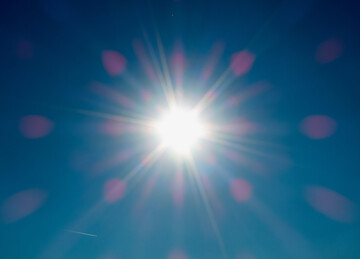How does the sun affect the weather?

The sun's heat affects the temperature and weather conditions.

The sun's heat affects the temperature and weather conditions.
Have you ever noticed how some days are really sunny and other days are cloudy and cool? That's because of the sun! The sun is a big star that shines light and heat on the earth.
The sun affects the weather in a lot of ways. One way is by heating up the earth's surface. When the sun shines on the ground, it warms it up. This is called "radiant heating." That's why it feels warmer outside when the sun is out.
Another way the sun affects the weather is by creating wind. When the sun heats up the earth's surface, it also heats up the air above it. This makes the air rise, and cooler air from other parts of the earth comes in to take its place. That movement of air is called wind.
The sun also affects the water on the earth. When it shines on the ocean or a lake, it heats up the water. That can create clouds, which can lead to rain or thunderstorms. In some places, the sun's heat causes evaporation, which means that water turns into vapor and rises into the air. That can also lead to rain.
Finally, the sun affects the seasons. In the summer, the sun is up in the sky for a long time and it's really hot outside. In the winter, the sun is lower in the sky and it's colder. That's because the earth is tilted on its axis, which means it's not always facing the sun in the same way.
So you see, the sun does a lot to affect the weather!
How does climate change affect the environment?
Climate change can have big effects on our environment. One of the main effects is rising temperatures. When the Earth gets warmer, it can cause glaciers and ice caps to melt. This can lead to rising sea levels, which can flood coastlines and affect animals and plants that live near the water. Rising temperatures can also make heatwaves more common, which can be dangerous for humans, animals, and plants.
Climate change can also affect weather patterns. It can cause more extreme weather events like hurricanes, floods, and droughts. These events can damage homes, cities, and habitats for animals and plants. For example, if a drought happens, it can make it harder for plants to get water, and they might not be able to grow as well. This can affect the animals and insects that rely on those plants for food or shelter.
Another way climate change affects the environment is by changing habitats. Some plants and animals have specific needs for temperature, water, and food. When their habitats change due to climate change, they might not be able to survive or find what they need. This can lead to a loss of biodiversity, which means there are fewer kinds of plants and animals in an area. For example, polar bears in the Arctic are losing their sea ice habitats because it is melting due to climate change. This makes it difficult for them to find food and raise their cubs.

The sun's heat affects the temperature and weather conditions.